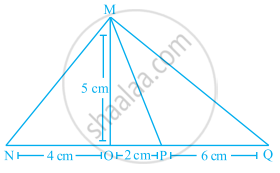Advertisements
Advertisements
प्रश्न
The area of a triangle is 5. Two of its vertices are (2, 1) and (3, −2). The third vertex lies on y = x + 3. Find the third vertex.
उत्तर
GIVEN: The area of triangle is 5.Two of its vertices are (2, 1) and (3, −2). The third vertex lies on y = x+3
TO FIND: The third vertex.
PROOF: Let the third vertex be (x, y)
We know area of triangle formed by three points (x1,y1) (x2,y2) (x3,y3)is given by
`Δ =1/2 [x_1y_2 +x_2y_3+x_3y_1) -(x_2y_1+x3_y_2+x_1y_3)`
NOW
Taking three point (x,y) (2,1) and (3-2)
`Δ=1/2[(x-4+3y)-(2y+3-2x)`
`Δ=1/2[3x+y-7]`
`5=1/2[3x+y-7]`
`+-10=3x+y-7`
`10=3x+y-7 or -10=3x+y-7`
`0=3x+y-17 ......(1) or 0=3x+y+3 .....(2) `
Also it is given the third vertex lies on y = x+3
Substituting the value in equation (1) and (2) we get
`+-10=3x+y-7`
`10=3x+y-7 `
`0=3x+y-17 ......(1)`
`0=3x+(x+3)-17`
`x=7/2`
Again substituting the value of x in equatin i we get
`0=3x+y-17 ......(1)`
`0= 3(7/2)+y-17`
`y=13/2`
Hence `(7/2,13/2) `
Similirly
`-10=3x +y-7`
`0=3x+y+3......(2)`
`0=3x+(x+3) `
`x=3/2`
Again subsitiuting the value of x in cquation 2 we get
`0=3x+y+3 ......(2)`
`0=3 ((-3)/2)+y+3`
`y=3/2`
Hence `((-3)/2 ,3/2)`
Hence the coordinate of `(7/2 ,13/2) and ((-3)/2,3/2)`
APPEARS IN
संबंधित प्रश्न
If the points A(−2, 1), B(a, b) and C(4, −1) are collinear and a − b = 1, find the values of a and b.
Find the area of the quadrilateral whose vertices, taken in order, are (-4, -2), (-3, -5), (3, -2) and (2, 3).
Find the value of k so that the area of the triangle with vertices A (k+1, 1), B(4, -3) and C(7, -k) is 6 square units
For what value of k(k>0) is the area of the triangle with vertices (-2, 5), (k, -4) and (2k+1, 10) equal to 53 square units?
Show that the following points are collinear:
(i) A(2,-2), B(-3, 8) and C(-1, 4)
Show that the following points are collinear:
A(-5,1), B(5, 5) and C(10, 7)
The table given below contains some measures of the right angled triangle. Find the unknown values.
| Base | Height | Area |
| 5 feet | ? | 20 sq.feet |
Points A(3, 1), B(12, –2) and C(0, 2) cannot be the vertices of a triangle.
The area of ∆ABC is 8 cm2 in which AB = AC = 4 cm and ∠A = 90º.
Ratio of areas of ∆MNO, ∆MOP and ∆MPQ in the given figure is ______.

